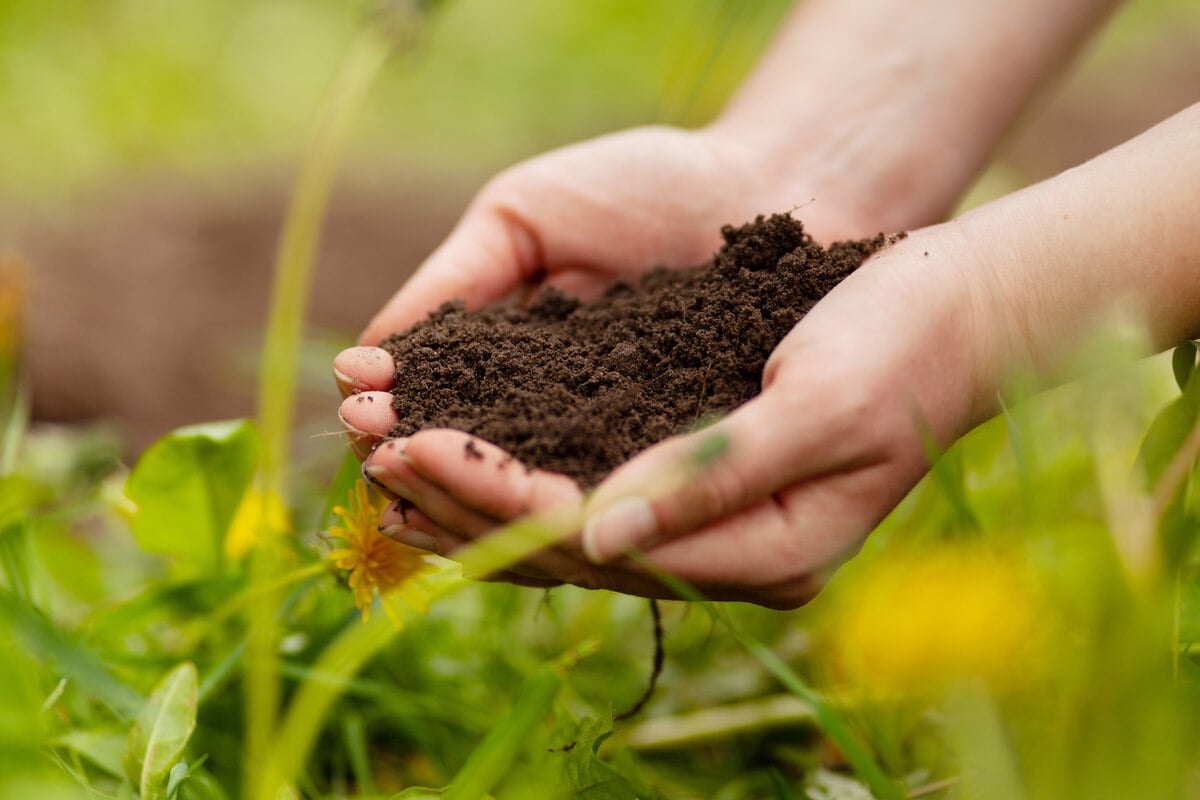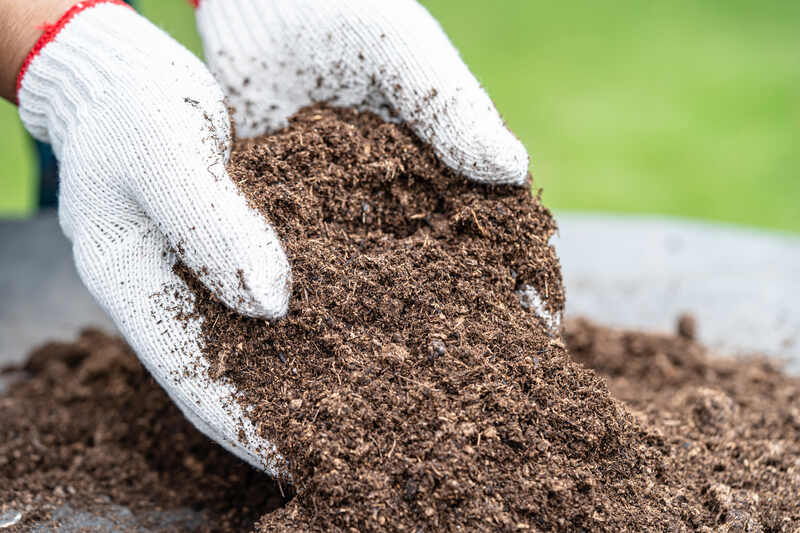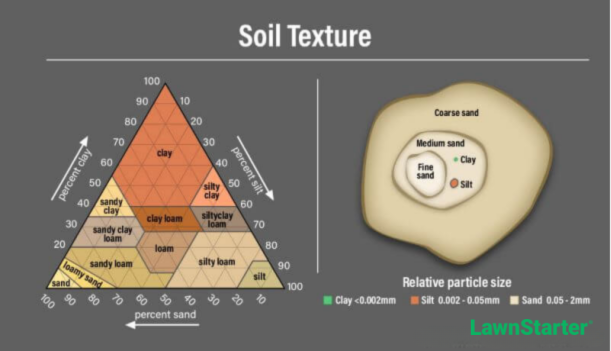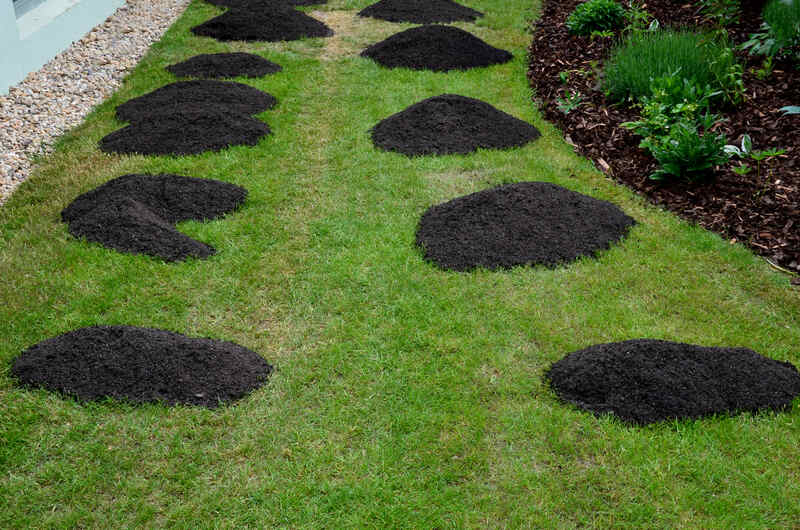
Sometimes, you can do everything right for your lawn, but the grass still refuses to green up. If your turf isn’t responding to fertilizers or irrigation, there may be something wrong with the soil. We’ll show you the main types of soil amendments, how to choose the right one for your yard, and a step-by-step application.
Improving soil looks different depending on whether you’re preparing the lawn for new grass or amending an existing lawn. If you’re prepping for a new lawn, grab the rototiller. If you’re amending an existing lawn, uncoil the water hose.
What Are Soil Amendments?
It’s easy to confuse fertilizers with soil amendments. Fertilizers add plant nutrients to the soil, whereas amendments are materials that change the condition of the soil.
Soil amendments change your soil’s physical properties so it can better support your lawn. You can use soil conditioners to improve naturally poor soils or to rebuild soils damaged by poor soil management.
Applied correctly, soil amendments help:
- Lower or raise the soil pH to the proper level for healthy grass (typically 5.5 to 6.5).
- Loosen the soil to help prevent compaction and encourage root growth.
- Add and support beneficial microorganisms like mycorrhizal fungi and nematodes that make nutrients available for plants and improve soil structure.
- Adjust the soil’s water retention and drainage. For example, soil amendments can help make heavy clay soils more permeable, and help sandy soils retain more water.
- Improve the soil’s nutrient-holding capacity. For example, biochar’s porous nature helps sandy soils absorb and store more nutrients.
- Add beneficial nutrients to the soil. Depending on the type of soil amendment, it can act as an amendment and fertilizer.
If your lawn is already established, improving the soil with soil amendments is more challenging than installing a new lawn. But still doable and with good results.
Let’s see what types of soil amendments you can use to improve your lawn.
Different Types of Soil Amendments for Turfgrass

Depending on how they can improve your soil, there are three main categories of soil amendments: soil texture, soil pH, and soil fertility amendments.
Soil Amendments for Texture and Drainage
Soil is made of mineral particles (clay, silt, sand) and organic matter, known as “humus.” The proportion of sand, silt, and clay particles defines your soil’s texture and how it stores nutrients and absorbs and drains water.
Depending on the ratio of sand vs. silt vs. clay, your soil falls into one of the categories in the graphic below:

For a deeper understanding of your soil’s texture and how you can test for it at home, read our detailed guide about the six main types of soil.
To discuss how soil amendments can help the different types of soil, we’ll focus in this article on the more unbalanced soils:
- Sandy soil (over 70% sand). It’s light soil with large, coarse particles, and feels gritty in your hand.
- Clay soil (over 40% clay). A heavy, tight texture with fine soil particles. It feels like talc when dry, and it’s sticky when wet.
- Silty soil (over 80% silt). Light, fertile soil with fine particles. When wet, it feels like silk and slippery in your hand.
Loamy soil is the ideal soil texture given by a mix of 40% sand, 40% silt, and 20% clay particles. Loam is the best soil for plant growth and is also suitable for turfgrasses if you maintain its good drainage and loose texture.
Best Amendments for Sandy Soil
Sandy soil has low water-holding and nutrient-storing capacity, so the main aim is to improve these two characteristics. The best soil conditioners to amend sandy soil include:
- Well-decomposed organic amendments such as compost, worm castings, sphagnum peat moss, and aged manure
- Vermiculite – a highly absorbent mineral soil additive that improves moisture and nutrient retention without affecting soil pH.
- Biochar – a porous carbon-like organic material that helps sandy soil absorb and store more soil nutrients.
- Greensand improves water retention and also the capacity of sandy soil to store nutrients like calcium, magnesium, and potassium.
Best Amendments for Clay Soil
In contrast to sandy soil, clay soil absorbs water slowly, but once absorbed into the soil, the ground stays moist for a long time. You’ll need to use amendments that loosen its structure, creating space for more efficient water absorption, drainage, and airflow, such as:
- Fibrous organic amendments such as composted wood chips, hardwood bark, and sawdust.
- Perlite is an inorganic soil amendment that loosens the soil structure and improves permeability.
- Gypsum binds the fine clay particles in small clumps, creating space for air and water.
Best Amendments for Silty Soil
Similar to clay, silty soil also suffers from water drainage and airflow problems, even if it is less tight on plant roots. Less popular in homeowners’ yards, silty soil is a near-water soil found around ponds and lakes. To improve its texture, use the same soil amendments as working with clay soil.
Soil Amendments to Adjust Soil pH
Soil pH tells you how acidic or basic your land is. It ranges between 0 (highly acidic) to 14 (highly alkaline) and varies with soil texture. The type of soil amendment you need for a healthy lawn depends on your soil’s pH:
| Soil pH | Type of Soil |
| Lower than 6.5 | Acidic soil has low amounts of plant-available nitrogen, phosphorus, and potassium and toxic levels of aluminum, manganese, and iron. |
| Between 6.6 and 7.4 | Neutral soil is the best for most plants. Doesn’t typically require pH correction. |
| Over 7.5 | Alkaline soil has low amounts of plant-available iron, a deficit that can lead to iron chlorosis (turf yellowing similar to nitrogen deficit). Other essential nutrients are also difficult to access. |
Best Amendments to Treat Acidic Soil
The most popular soil amendments for rising pH in acidic soil are:
- Agricultural lime (garden lime or limestone): Contains calcium carbonate (calcitic lime) and sometimes magnesium carbonate (dolomitic lime). Check your soil test for the recommended amount of lime amendment per 1,000 square feet.
- Wood ash: Rich in calcium (which raises soil pH) but also has phosphorus, potassium, and magnesium working as a light fertilizer.
Best Amendments to Treat Alkaline Soil
The best soil amendments to lower pH in alkaline soil are:
- Elemental sulfur: When the lawn turns yellow, most homeowners assume it’s nitrogen deficient. However, the yellowing may indicate iron chlorosis. Iron becomes less available when the soil is alkaline (above 7.0 pH). You can lower the soil pH level to a slightly acidic, neutral range by applying elemental sulfur.
- Aluminum sulfate and iron sulfate: They work faster than elemental sulfur. However, you’ll need larger amounts, and aluminum sulfate can lead to toxic levels of aluminum in the soil if overused.
- Sphagnum peat moss: Look for Canadian peat moss or a product with a pH of 3.0 to 4.5, acidic enough to lower soil pH.
- Ericaceous compost: Acidic compost with a pH of 4 to 5 made of pine needles, citrus peels, oak bark, etc.
Most turf types thrive in slightly acidic soil with a pH of 5.5 to 6.5, but each type has its preferred pH interval, as shown in the table below.
| Preferred Soil pH | Types of Turfgrass |
| 5.0 to 6.0 | Carpetgrass, centipedegrass |
| 5.5 to 6.5 | Bahiagrass, tall fescue, creeping bentgrass |
| 6.0 to 6.5 | Bermudagrass, Zoysiagrass, fine fescues |
| 6.0 to 7.0 | Perennial ryegrass |
| 6.0 to 7.5 | St. Augustinegrass, Kentucky bluegrass |
| 6.5 to 7.5 | Buffalograss |
| 6.6 to 8.4 | Blue grama |
| 3.6 to 10.2 | Seashore paspalum grass |
Compare the ideal soil pH interval for your grass with the tested level. If it doesn’t fit, add suitable soil amendments to correct it.
Soil Amendments to Boost Fertility
Some soil amendments also work as natural fertilizers, adding valuable nutrients to the soil.
| Soil Amendment | Main Nutrients Added to Soil |
| Grass clippings | Nitrogen, phosphorus, potassium |
| Composted or aged manure | Nitrogen, phosphorus, potassium |
| Alfalfa meal | Nitrogen, phosphorus, potassium, magnesium, sulfur |
| Blood meal | Nitrogen, phosphorous, potassium |
| Bone meal | Phosphorus, calcium, nitrogen |
| Rock phosphate | Phosphorus, calcium |
| Greensand (glauconite) | Potassium, iron, calcium, magnesium, phosphorus |
| Wood ash | Calcium, potassium, phosphorus, and magnesium |
| Gypsum | Calcium, sulfur |
| Kelp (seaweed) | Nitrogen, potassium, calcium, trace minerals (iron, zinc, manganese, bor, copper) |
| Mushroom compost | Calcium, potash, iron, phosphate, magnesium |
Best Type of Soil Amendment Overall
The best type of soil amendment is organic matter. Organic material is magic for your yard. It can solve nearly any physical problem your soil may have:
- Reduces soil compaction in clay soils by loosening its structure
- Improves drainage and aeration in clay, compacted soils
- Improves water retention in sandy soils
- Provides food for soil organisms that encourage lawn and soil health, such as earthworms
- Acts as an organic fertilizer
- Adds microbes that help release nutrients to plant roots
Examples of organic amendments include:
- Compost
- Wood ash
- Composted animal manure
- Shredded leaves
- Humus
- Peat moss
- Sawdust
- Worm castings
How to Improve Your Lawn Using Soil Amendments

In this section, we take you step by step through the process from deciding on whether or not you need soil amendments all the way to the application stage.
Step 1: Test the Soil
How Do You Know You Need Soil Amendments? If your grass grows slow and thin or you notice the soil dries too fast or stays wet for too long, your lawn might need some soil amending. But you won’t know for sure until you take a soil test.
Amending the soil isn’t a guessing game. Why? Because applying the wrong soil conditioner (or the wrong amount) can do more harm than good.
You can use a DIY soil test kit to check soil pH and main nutrients (nitrogen, potassium, phosphorus). However, you’ll get better and more precise results if professionals test your soil. A laboratory test at the nearest Cooperative Extension Office will reveal the best amendment for your type of soil and how much to apply.
Step 2: Choose the Right Soil Conditioner for Your Lawn
When choosing a suitable soil conditioner, consider:
- The type of soil growing your grass (clay, silty, sandy, loamy)
- Soil’s pH
- Nutrient deficit, as shown by the soil test
- The type of grass you’re growing and its soil needs.
Slightly acidic (pH of 6.5 to 7), friable loam is the best soil for turfgrass and the texture to aim for.
Step 3: Apply the Soil Amendments
The way you add soil conditioner to your lawn depends on whether you’re preparing to install new turf or trying to improve the health of established grass.
Work Amendment Into the Soil For a New Lawn
If preparing the ground for installing a new lawn, add the recommended amendment to the bare soil (remember to refer to your soil test results). Depending on soil amendment, you’ll need to spread a 1- to 4-inch thick layer.
After spreading the amendment across the yard, work it 6 inches deep into the soil. The best way to mix the soil and amendment material is with a rototiller.
Pro Tip: Do not perform this step when the soil is too wet or dry. Otherwise, you’ll destroy the soil structure. If the soil is wet enough to come together into a ball but dry enough that it shatters when you drop it on the ground, the ground is ready to till.
Sprinkle Amendment on Established Lawn
If you’re amending soil for an established lawn, you won’t be able to work the amendment into the ground (doing so will destroy your yard). Instead, spread the recommended amendment over the lawn as topdressing and water it deeply into the soil.
Note: A “deep watering” wets the soil down to at least 6 inches, according to Kansas State Extension. If you have clay or dense soil, cycle the sprinklers to allow water to soak into the soil and prevent runoff. (This is called the cycle and soak method.)
For example, if you normally run a zone for 20 minutes, break that up into two or three cycles with 30 to 60 minutes rest between each cycle. This will help achieve a deep soak and strong root growth for your grass without any runoff or erosion.
Pro Tip: Increase soil exposure by aerating and dethatching the lawn before application. These lawn tasks will help the amendment penetrate the soil.
FAQ About Soil Amendments
Will Adding Sand Improve Drainage in Clay Soil?
No, sand is not a suitable soil amendment for clay soil. Most people assume that sand will increase drainage in clay soil, but it does the opposite. The sand and clay create a soil structure that’s similar to concrete. The soil becomes compacted, which means water can’t penetrate the soil.
Can Soil Amendments Add Nutrients to the Soil?
Yes, soil amendments can add nutrients to the soil, but that doesn’t mean all soil amendments are fertilizers. Remember, amendments are like a conditioner for the soil, whereas fertilizers provide nutrients. However, some soil amendments add nutrients as a nice bonus.
Are Soil Amendments and Mulch the Same Thing?
Soil amendments work differently from mulch. Soil amendments are worked into the soil to improve the soil’s physical properties. On the other hand, mulch is applied to the soil surface to block weed seeds, add nutrients, and retain moisture. Keep in mind that you can use some materials as either mulch or soil amendments, such as compost or wood chips.
Can I Add Soil Amendments to My Garden?
Yes, soil amendments are perfect for your garden soil. Add amendments to flower garden beds and your vegetable garden.
When to Hire a Professional
Your lawn’s success depends mainly on the health of its soil. But it also depends on how well you take care of the grass. Don’t waste all that soil prep by skipping out on your lawn care chores. Use the LawnStarter website to connect with a local lawn care professional who can take the load off your hands, from mowing the grass to fertilizing the soil.
Main Photo Credit: Andrii Zastrozhnov / Adobe Stock Free / License